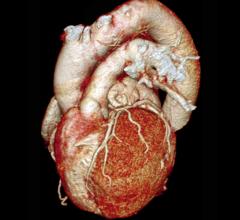What makes cardiologists more capable of reading cardiac imaging exams than other physicians such as radiologists, who are specifically trained to read coronary CT, cardiac MRI, PET and so on?
As new cardiology fellowship tracks adopt cardiovascular imaging into their curriculum and the cardiology community develops its own appropriateness criteria for imaging tests, cardiologists are gaining competency in cardiac image interpretation. Has the game now changed to where both cardiologists and radiologists are skilled in reading these exams, yet, because of their expertise in the cardiovascular system, cardiologists are the quarterbacks of cardiac imaging?
To find out, we asked Mark A. Turco, M.D., FSCAI, Washington Adventist Hospital, Takoma Park, MD, who is an interventional cardiologist and member of SCAI as well as a board member of the Imaging Council for the SCAI and ACC. Dr. Turco performs a wide range of high-volume peripheral vascular and coronary interventional work, and his peripheral work runs the gamut from carotid to aortic to thoracic interventional procedures.
Diagnostic and Invasive Cardiology (DAIC): In your opinion, why are cardiologists best suited for cardiac imaging reads?
Dr. Turco: From the society’s standpoint, we believe that cardiologists are best equipped mainly because we are in the best position to treat patients from a patient-centered care platform. That’s a key point — we can take an imaging study and really apply that imaging study, whether it’s an imaging study in the periphery or in the coronary realm through, for example, a coronary CT or a cardiac MRI or a PET scan, which is a little less frequently used today, and apply the findings to the patient. This enables us to apply that particular test to the information we know from the patient’s history, from the patient’s physical examination and from the standpoint of other tests that the patient may have undergone. With all of that information, we can develop a good treatment plan for that individual patient. So cardiologists are best equipped with respect to cardiovascular imaging.
DAIC: If a radiologist refers to the patient’s history when reading a coronary CT or cardiac MR, how does the cardiologist’s perspective differ?
Dr. Turco: From the standpoint of radiologists who may be reading a coronary CT or a cardiac MR, the patient history that they have is only whatever was given to them from the standpoint of the order, the requisition. The cardiologist’s standpoint is different, more directly involved. The cardiologist and his or her care team have seen the patient and are able to take the results of the imaging test and apply those results to the patient themselves. Thus, there is some continuity of care for that patient. They can see one specialist. I think that in general is what patients want. They want to go to the most experienced person who is the quarterback for their particular care, and if that physician is a cardiovascular specialist, cardiovascular imaging comes into that continuity of care aspect.
DAIC: Are there studies comparing cardiologist reads with that of other clinicians?
Dr. Turco: For the more recent type of testing we are looking at, for example, coronary CT work or cardiac MR, there is no head-to-head testing of which I’m aware. You need to have a particular test and have a cardiologist read and a radiologist read and compare how that relates.
One area where cardiologists may be best equipped to interpret some of these studies is coronary CT and cardiac MR, and that’s because cardiologists have performed most of the research in the field. Many of the clinical trial work and evaluation that has led to the utilization of coronary CT and cardiac MR has been performed in the hands of the cardiologist, not so much in the radiologist community.
DAIC: Is there a need for further trials comparing radiologist and cardiologist reads?
Dr. Turco: What we as cardiologists are much more concerned with is what is in the best interest of the patient. Cardiologists in general are very dedicated to the field of cardiovascular imaging and have an intense desire to see what is in the patient’s best interest. Going back to patient-centric care and the continuity of care, the cardiovascular field and the specialist in cardiovascular diseases are the most experienced with the cardiovascular system. I truly feel that the cardiologists are going to be the ones who are ultimately best suited to move the field of cardiovascular imaging further.
The issue is not a turf battle and we don’t want to make it one. The point is what is best for the patient. There may be areas where some of these studies can cross over disciplines, and that the two groups can work together in the patient’s best interest to provide the highest level and quality of care.
DAIC: Is there a need for more training on imaging reads amongst cardiologists?
Dr. Turco: Absolutely. Most cardiology fellowship tracks have a clear path toward cardiovascular imaging that will lead to more experienced fellows in the field of cardiology coming out with specialized training in coronary CT and cardiac MR. And SCAI is very involved in efforts related to credentialing and clinical competency and standards, which need to be set up. In addition, what we need to work on as a Society is appropriateness criteria for determining the appropriate time to perform cardiac imaging with CT versus MR. That is critical so we ensure the best information is provided to the physicians for making the best treatment decisions.
Further training and, more importantly, the issues of competency, credentialing and appropriateness standards for these imaging tests, are critical as these fields continue to evolve. We are working very hard to develop these appropriateness criteria. There are imaging councils that have been set forth with all of the imaging fields within cardiovascular disease to help provide these appropriateness criteria so they are set forth and well written and published in peer-reviewed journals. They will then act as the framework for what physicians can use as to which tests to order, when to order them and how to make these treatment decisions.
It is very important that these procedures do not get over utilized or the wrong type of test be ordered for the wrong type of patient. It’s very important that education occurs along those lines.
DAIC: Will these appropriateness criteria affect both patient care and reimbursement issues?
Dr. Turco: Yes. It will ultimately be for both because again the patient care aspect is No. 1. If someone orders a coronary CT scan for a patient with an unstable coronary syndrome, that is certainly not the appropriate test. Or if somebody is ordering a coronary CT scan for a patient who has a very high creatinine and renal insufficiency, that can certainly do harm to a patient. That is where we have to look at appropriateness criteria and education. As you well know, there is pay-for-performance and it will be very important that the payors see that the physicians are utilizing these studies in a very appropriate manner.


 December 19, 2024
December 19, 2024 








